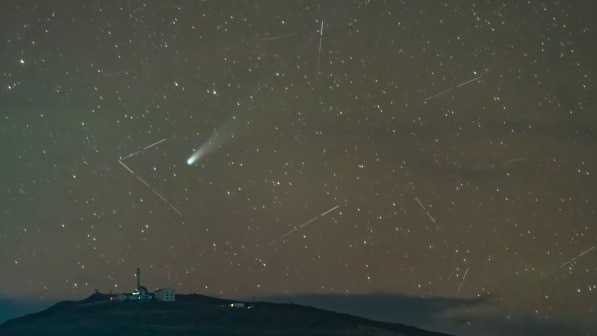Comet Lemmon Captured in Stunning Video from Ladakh’s Hanle Observatory
Astrophotographer Dorje Angchuk has captured breathtaking footage of Comet Lemmon streaking across the pristine night skies of Hanle, Ladakh, one of the world’s highest astronomical sites.
Key Highlights
- Comet Lemmon (C/2023 A3) captured in video from Hanle’s dark-sky sanctuary
- Faint greenish tail visible beneath the Milky Way’s arc
- Comet making closest approach to Earth this month
- Hanle’s exceptional viewing conditions showcased
Mesmerising Celestial Display
The video shows Comet Lemmon’s faint greenish tail glowing subtly beneath the sprawling arc of the Milky Way. Recorded from Hanle’s crystal-clear plateau, the footage highlights the region’s status as India’s premier dark-sky sanctuary.
Dorje Angchuk, scientist-in-charge at the Indian Astronomical Observatory, documented the rare spectacle that’s now being widely shared among astronomy enthusiasts.
Comet’s Close Approach
Comet Lemmon — officially designated C/2023 A3 (Lemmon) — has been making its closest approach to Earth this month, thrilling skywatchers globally. The comet features a long, ionised tail and rapidly brightening coma as it interacts with solar radiation while nearing the Sun.
“Even in the quiet skies of Hanle, Comet Lemmon shares its stage with the ever-growing traces of human presence,” said Angchuk, who also serves as the observatory’s engineer-in-charge.
Scientific Significance
First discovered by astronomers using the Mount Lemmon Survey in Arizona, Comet Lemmon represents remnants of the early solar system. Astronomers note such comets contain pristine material billions of years old, offering valuable insights into our cosmic origins.
India’s Growing Role in Astronomy
The Indian Astronomical Observatory in Hanle, operated by the Indian Institute of Astrophysics, has long been a hub for celestial discoveries. Angchuk’s footage not only celebrates Hanle’s extraordinary viewing conditions but also showcases India’s expanding contribution to global sky observation and science outreach.
Scientists expect Comet Lemmon to remain visible for a few more days to observers under dark skies — a fleeting but glorious celestial visitor reminding us of the timeless beauty above.




